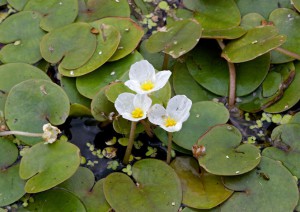 In riverine back-waters, ponds and lakes, small leaves often occur. Rounded and heart-shaped at base, they resemble those of water-lilies, lessened several times. Those are the leaves of the frogbit. Downward from the shortened stem, descend numerous fleshy roots with air pockets – hence the plant floating.
In riverine back-waters, ponds and lakes, small leaves often occur. Rounded and heart-shaped at base, they resemble those of water-lilies, lessened several times. Those are the leaves of the frogbit. Downward from the shortened stem, descend numerous fleshy roots with air pockets – hence the plant floating.
The Russian common name of it refers to its blossoming, when it decorates the waters around indeed. The small exquisite flowers with three white petals, bright yellow pistils and stamens come in perfect harmony to the dark still-water. Some of the plants are home to pistillate and some to the staminate flowers. As was mentioned, these are the dioecious plants.
The frogbit fruits rarely develop; the plant mainly propagates asexually. From the shorted stem, just like the runners of strawberries, new twigs shoot out with rosettes of younger species.
By the fall, the frogbit develops another type of shoots – thin and budded at the tips. The buds shed to the bottom and winter there. In the spring, air pockets emerge in them, and they surface. They give life to new plants.
The wintering buds of frogbit are covered in a jelly coat. They stick to the feet of waterfowls and fur of aquatic animals. That is how animals help it settle in other water bodies.
/ * The photos at lake.peipsi.org are cross-posted from commons.wikimedia.org and are used for familiarization purposes only. No commercial use of the photos is allowed. For more information about to use the photos see the originals on commons.wikimedia.org. /


